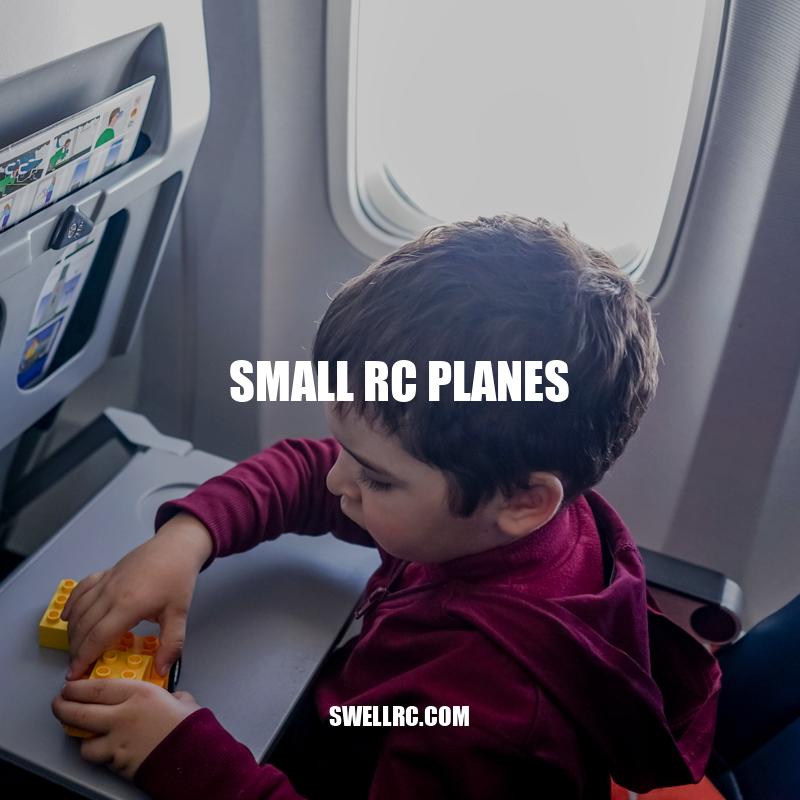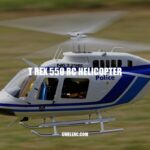Small RC Planes: The Perfect Introduction to Remote Control Flying
If you’re looking for a fun and affordable way to experience the thrill of flying, small RC planes may be just what you need. These miniaturized planes offer a great introduction to the world of remote control (RC) flying. They are more manageable in terms of size, cost, and maintenance, making the hobby accessible to almost everyone, including kids and beginners. Small RC planes come in various shapes, sizes, and types, from trainers and sport flyers to aerobatic planes and gliders. Each has its distinct features, characteristics, and flying capabilities that cater to different interests and skill levels. Additionally, small RC planes are easy to transport and don’t require large flying fields, as you can fly them in the park, backyard, or even indoors. That means you don’t have to worry about travel time and expenses or club memberships as long as you adhere to safe flying practices and regulations. In this article, we’ll guide you on how to choose the right small RC plane, provide some flying tips and tricks, and show you how to maintain your plane for prolonged use so you can enjoy the hobby to the fullest.
Choosing the Right Small RC Plane
Before you buy your first small RC plane, you need to consider some essential factors to ensure the best experience. Here are some things to keep in mind:
- Type of RC Plane: Small RC planes fall into different categories, such as sport, 3D aerobatic, glider, or micro flyers. Choose the type that matches your preference, skill level, and flying environment.
- Construction Quality: Check the plane’s materials, durability, and build quality. Foam planes are lightweight and durable, while balsa wood planes require more care but offer better realism and precision.
- Size and Weight: Small RC planes come in various sizes and weights, but the smaller ones tend to be more affordable and easier to handle. Consider your skill level, flying space, and battery capacity when choosing the appropriate size and weight.
- Power Source: Most small RC planes use electric motors because they are cleaner, quieter, and affordable. Others operate on gas-powered engines, which are more powerful and realistic but require more maintenance. Choose the type of power source that suits your needs and budget.
- Flight Time and Range: Check the plane’s battery life and transmitter range to make sure they meet your flying expectations. You don’t want to run out of power in midair or lose control of your plane due to inadequate signal range.
Once you have narrowed down your options, consider purchasing your small RC plane from reputable online sellers or local hobby stores. Some popular websites to buy small RC planes include Horizon Hobby, Tower Hobbies, and Amazon. These platforms offer a wide range of models, accessories, and replacement parts at competitive prices. You can also find valuable resources and customer reviews to help you make informed decisions.
What types of RC planes are there?
Remote Control or RC planes come in a variety of shapes and sizes, each with its own unique flying abilities and features. Here are some of the most popular types of RC planes.
1. Glider RC Plane: These RC planes are designed for soaring and gliding through the air, using the air currents to sustain their flight. They are ideal for beginners, as they are easy to operate and do not require a lot of power.
2. Trainer RC Plane: These RC planes are designed for novice pilots who are learning to fly. They have stable flight characteristics and are simple to operate, making them the perfect choice for those who are just starting out.
3. Sport RC Plane: These RC planes are designed with aerobatics and stunts in mind. They are more powerful than other planes and can perform flips and rolls, making them an excellent choice for experienced pilots.
4. Scale RC Plane: These RC planes are designed to look like real-life aircraft, such as fighter jets, commercial airliners, and even helicopters. They are a popular choice for collectors and enthusiasts.
5. Micro RC Plane: These RC planes are small and lightweight, making them perfect for indoor flying. They are easy to operate and can provide hours of fun and entertainment.
6. Jet RC Plane: These RC planes are designed to mimic the speed and power of a real jet. They are incredibly fast and can reach speeds of up to 200 mph, making them a popular choice for experienced pilots.
As you can see, there are many different types of RC planes to choose from, each with its own unique features and capabilities. So, whether you’re a beginner or an experienced pilot, there’s an RC plane out there that’s perfect for you.
Whether you are a novice or experienced RC pilot, safety is always a top priority when flying small RC planes. Here are some tips to help you fly safely and enjoyably:
- Choose the Right Flying Area: Pick an open space away from people, animals, and obstacles that may interfere with your flying experience. Look for your local RC flying clubs or parks that have designated RC flying areas.
- Check Your Equipment: Before each flight, perform a pre-flight check on your small RC plane, transmitter, and battery to ensure they are functioning correctly. Always bring spare batteries, propellers, and tools for quick repairs or replacements.
- Respect the Airspace and Rules: Follow the regulatory rules for RC flying in your area, such as altitude limits, flying hours, and noise restrictions. Never fly your small RC plane near airports, military bases, or prohibited areas.
- Practice and Improve Your Skills: Spend time practicing your flying skills on a simulator or with a professional instructor to improve your control, precision, and safety. Learn new tricks and techniques, such as loops, rolls, and inverted flights, and gradually increase your difficulty level.
- Share the Fun with Others: Join local RC flying clubs or social media groups to connect with like-minded enthusiasts and share your flying experiences, tips, and tricks. Attend RC flying events, competitions, and exhibitions to learn from the experts and showcase your skills.
Interesting Fact: Did you know that the world’s smallest remote control plane is the Nano Falcon? It weighs only 11 grams and fits in the palm of your hand!
| Name | Size (inches) | Range (feet) | Flight Time (minutes) | Price (USD) |
|---|---|---|---|---|
| E-flite UMX Turbo Timber | 28.15 x 19.69 x 35.43 | 200-300 | 8-10 | $129.99 |
| HobbyZone Mini Apprentice S | 43.31 x 36.42 x 9.85 | 1000 | 10-15 | $219.99 |
| Flyzone Mini Switch | 24.4 x 21.5 x 7.3 | 200-400 | 10-12 | $99.99 |
| Dromida Twin Explorer | 22 x 17.3 x 5.9 | 300 | 12-15 | $69.99 |
Note: The table includes some small RC planes that are popular among beginners and come in various sizes, ranges, and prices. Please check the manufacturer’s website for detailed specifications and features before purchasing.
What’s the easiest RC plane to fly?
When it comes to finding the easiest remote controlled (RC) plane to fly, there are a few key factors to consider. The level of experience the pilot has, the type of terrain they are flying on and the features of the RC plane are all important aspects to take into account.
For beginner pilots, it is recommended to start with a high-wing trainer plane. These planes have a stable flight pattern and are less likely to nose dive or spin out of control. They also tend to fly at a slower speed which allows for more reaction time and less chance of crashing.
Some popular options for easy-to-fly RC planes include the HobbyZone Sport Cub S, the E-flite Apprentice STS and the Volantex Super Cub. These planes are all designed for novice pilots and include features such as built-in stabilization systems and beginner modes that limit the speed and flight range until the pilot gains more confidence.
It’s important to note that flying an RC plane can still be a challenging and rewarding experience even with an easier-to-fly plane. But with the right equipment and a bit of practice, anyone can become a skilled RC pilot. So if you’re looking for a manageable way to enter the world of RC planes, consider starting with a high-wing trainer plane like the ones mentioned above.
If you’re new to RC flying, choosing the right small RC plane for you can be overwhelming. Here are three great options for beginners:
- HobbyZone Mini Apprentice S: This small RC plane is easy to fly and has a durable design that can withstand a few crashes. With its SAFE technology, it provides stability and prevents crashes. Its three modes are ideal for beginners who have never flown before, intermediates gaining piloting experience, and experts performing aerobatics.
- Volantex Super Cub 500: This small RC plane is a great choice for beginners due to its simple design. It also has a 6-axis gyro system that provides stability and easy maneuvering, making it a great choice for first-time pilots. The Volantex Super Cub 500 can fly up to 25 minutes, providing plenty of time for new pilots to gain experience.
- E-flite UMX Timber: This small RC plane is a fantastic choice for beginners who want to try a high-quality RC plane. The Timber’s AS3X system provides stability, while its oversized wheels are perfect for rough areas. Also, it features SAFE technology that helps you to avoid the possible damage done by crashes.
Remember, these are just a few of the many small RC planes available on the market. It’s always best to do your research and choose a model that suits your specific needs and interests.
Note: The mentioned small RC planes are available on Amazon, and their prices may vary based on the seller and current promotions. Please check the manufacturer’s website for detailed specifications and features before purchasing.
Conclusion
Small RC planes are an excellent starting point for anyone interested in remote control flying. With their affordability and ease of use, they offer a great introduction to the hobby while still providing an exciting flying experience. When selecting a small RC plane, it’s essential to consider your skill level, the type of flying you want to do, and the features you require. By choosing the right plane and following the manufacturer’s instructions, you can enjoy hours of flying fun. Remember, practice makes perfect, so don’t be discouraged by crashes or mistakes; they are part of the learning process.
Finally, there are many excellent resources available online, such as RC forums and instructional videos, that can help you improve your flying skills and connect with other enthusiasts. Also, manufacturers such as Horizon Hobby, Tower Hobbies, and E-Flite offer a wide range of small RC planes and accessories for every skill level. Whether you’re a beginner or an experienced pilot, there is always something new to learn in the exciting world of RC flying.



